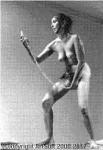Carolee Schneemann
Carolee Schneemann
Place: Fox Chase
Born: 1939
Biography:
Carolee Schneemann is an American visual artist, known for her discourses on the body, sexuality and gender. She received a B.A. from Bard College and a Master of Fine Arts from the University of Illinois. Her work is primarily characterized by research into visual traditions, taboos, and the body of the individual in relation to social bodies. Her works have been shown at the Los Angeles Museum of Contemporary Art, the Museum of Modern Art in New York, the London National Film Theatre, and many other venues.
Schneemann has taught at several universities, including the California Institute of the Arts, the School of the Art Institute of Chicago, Hunter College, and Rutgers University. Additionally, she has published widely, producing works such as Cézanne, She Was a Great Painter (1976) and More than Meat Joy: Performance Works and Selected Writings (1997). Her works have been associated with a variety of art classifications including Fluxus, Neo-Dada, performance art, the Beat Generation, and happenings.
Carolee Schneemann was born and raised in Fox Chase, Pennsylvania. As a child, her friends described her in retrospect as "a mad pantheist", due to her relationship with, and respect for, nature. As a young adult, Schneemann often visited the Philadelphia Museum of Art, where she has cited her earliest connections between art and sexuality to her drawings from ages four and five, which she drew on her father's prescription tablets. Her family was generally supportive of her naturalness and freeness with her body. Schneemann attributed her father's support to the fact that he was a rural physician who had to often deal with the body in various states of health.
Schneemann was awarded a full scholarship to New York's Bard College. She was the first woman from her family to attend college, but her father discouraged her from an art education. While at Bard, Schneemann began to realize the differences between male and female perceptions of each other's bodies while serving as a nude model for her boyfriend's portraits and while painting nude self-portraits. While on leave from Bard and on a separate scholarship to Columbia University, she met musician James Tenney, who was attending The Juilliard School.
Her first experience with experimental film was through Stan Brakhage, her and Tenney's friend. After graduating from Bard in 1962, Schneemann attended the University of Illinois for her graduate degree.
Carolee Schneemann began her art career as a painter in the late 1950s. Her painting work began to adopt some of the characteristics of Neo-Dada art, as she used box structures coupled with expressionist brushwork. These constructs share the heavily textural characteristics found in the work of artists such as Robert Rauschenberg. She described the atmosphere in the art community at this time as misogynistic and that female artists of the time were not aware of their bodies. These works integrated influence by artists such as post-impressionist painter Paul Cézanne and the issues in painting brought up by the abstract expressionists. Schneemann chose to focus on expressiveness in her art rather than accessibility or stylishness. She still described herself as a formalist however, unlike other feminist artists who wanted to distance themselves from male-oriented art history. She is considered a "first-generation feminist artist", a group that also includes Mary Beth Edelson, Rachel Rosenthal, and Judy Chicago. They were part of the feminist art movement in Europe and the United States in the early 1970s to develop feminist writing and art. Schneemann became involved with the art movement of happenings when she organized A Journey through a Disrupted Landscape, inviting people to "crawl, climb, negotiate rocks, climb, walk, go through mud". Soon thereafter she met Allan Kaprow, the primary figure of happenings in addition to artists Red Grooms and Jim Dine. Influenced by figures such as Simone de Beauvoir, Antonin Artaud, Maya Deren, Wilhelm Reich, and Kaprow, Schneemann found herself drawn away from painting.
In 1962, Schneemann moved with James Tenney from their residence in Illinois to New York when Tenney obtained a job with Bell Laboratories as an experimental composer. Through one of Tenney's colleagues at Bell, Billy Klüver, Schneemann was able to meet figures such as Claes Oldenburg, Merce Cunningham, John Cage and Robert Rauschenberg which got her involved with the Judson Memorial Church's art program. There, she participated in works such as Oldenburg's Store Days (1962), and Robert Morris's Site (1964) where she played a living version of Édouard Manet's Olympia. She contributed to Oldenburg's happening, filmed by Stan VanDerBeek in upstate New York, Birth of the American Flag (1965). Around this time she began to self-represent her nude body in works, feeling that it needed to be seized back from the status of a cultural possession. Schneemann got to personally know many New York musicians and composers in the 1960s as well, including George Brecht, Malcolm Goldstein, Philip Glass, Terry Riley, and Steve Reich. She was also highly interested in the abstract expressionists of the time, such as Willem de Kooning. However, despite her numerous connections in the art world, Schneeman's painting-constructions did not generate interest from New York art dealers, though Oldenburg suggested that there would have been more interest from Europe. The first support for Schneemann's work came from poets such as Robert Kelly, David Antin, and Paul Blackburn who published some of her writings.
More...
Wikipedia link: Click Here


